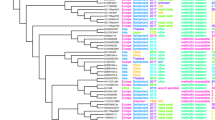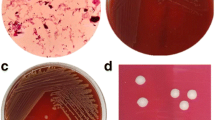Abstract
This study reports a rare fatal case of Chromobacterium violeceum OUAT_2017 strain infection in an Asiatic elephant calf in India. Necropsy revealed pus-filled nodules in liver, spleen, and lungs. Nutrient broth cultures of nodule content showed sediment of violet pigment whereas smooth, non-diffusible, violet-pigmented, homogeneous colonies appeared on nutrient agar. The organism was found to be non-haemolytic and resistant to 8 of the 24 antibiotics tested in vitro. Partial 16S rRNA gene sequence measuring 1410 bp revealed 97% homology with C. violeceum. The bacterial genome composed of 64.87% of G + C content with total size of 4,681,202 bp. The genome annotation has 42 genes responsible for multidrug antibiotic resistance with the presence of Aminoglycoside-modifying enzymes (AAC (6’)) that targets streptomycin and spectinomycin. Our findings corroborated the lethal effect of C. violeceum in a new host (elephant) that enriched scientific information on epidemiological picture and whole genome sequencing as well.


Similar content being viewed by others
References
Chowdhury M, Lee N, Wey QE (2021) Chromobacterium violaceum causing disseminated soft tissue and pulmonary abscesses in a traveler returning from the Azores. Access Microbiol 3:8. https://doi.org/10.1099/acmi.0.000251
Frawley AA, Powell L, McQuiston JR, Gulvik CA, Bégué RE (2018) Necrotizing pneumonia caused by Chromobacterium violaceum: report of a rare human pathogen causing disease in an immunodeficient child. Am J Trop Med Hyg 99:164–167. https://doi.org/10.4269/ajtmh.18-0060
Crosse PA, Soares K, Wheeler JL, Cooke KL, Adin CA, O’Kelley JJ, Levy JK (2006) Chromobacterium violaceum infection in two dogs. J Am Anim Hosp Assoc 42:154–159
Ansari S, Paudel P, Gautam K, Shrestha S, Thapa S, Gautam R (2015) Chromobacterium violaceum isolated from a wound sepsis: a case study from Nepal. Case Rep Infect Dis. https://doi.org/10.1155/2015/181946
Baker S, Campbell JI, Stabler R, Nguyen HVM, To DS, Nguyen DV (2008) Fatal wound infection caused by Chromobacterium violaceum in Ho Chi Minh City. Vietnam J Clin Microbiol 46:3853–3855. https://doi.org/10.1128/JCM.01068-08
Menezes CB, Tonin MF, Corrêa DB, Parma M, de Melo IS, Zucchi TD (2015) Chromobacterium amazonense sp. nov. isolated from water samples from the Rio Negro, Amazon. Braz Antonie Van Leeuwenhoek 107:1057–1063. https://doi.org/10.1007/s10482-015-0397-3
Simmons J, Gibson S (2012) Nonhuman primates in biomedical research. In: Bacterial and mycotic diseases of nonhuman primates. 2nd edn. vol II, Chapter 2: p 105–172
Slesak G, Douangdala P, Inthalad S, Silisouk J (2009) Chromobacterium violaceum septicaemia in northern Laos, a modified oxidase test and post-mortem forensic family G6PD analysis. Annals Clin Microbiol Anti-microb 8:24
Pant ND, Sharma M (2015) Urinary tract infection caused by Chromobacterium violaceum. Int J Gen Med 10:293–295. https://doi.org/10.2147/IJGM.S89886
Hota B, Sahu SK, Behera BK, Pahari A, Sahoo N (2020) Microbiological and molecular diagnosis of Mycobacterium tuberculosis infection in spotted deer (Axis axis) of an Indian Zoo. J Curr Microbiol App Sci 9:844–851. https://doi.org/10.20546/ijcmas.2020.906.107
Anon Clinical and Laboratory Standards Institute (2014) Performance standards for antimicrobial susceptibility testing Twenty-Fourth informational supplement, vol 34. Clinical and Laboratory Standards Institute, Wayne
Heuer H, Krsek M, Baker P, Smalla K, Wellington EM (1997) Analysis of actinomycete communities by specific amplification of genes encoding 16S rRNA and gel-electrophoretic separation in denaturing gradients. Appl Environ Microbiol 63:3233–3241. https://doi.org/10.1128/aem.63.8.3233-3241.1997
Wick RR, Judd LM, Gorrie CL, Holt KE (2017) unicycler: resolving bacterial genome assemblies from short and long sequencing reads. PLoS Comput Biol 13:e1005595. https://doi.org/10.1371/journal.pcbi.1005595
Brettin T, Davis JJ, Disz T, Edwards RA, Gerdes S, Olsen GJ, Olson R, Overbeek R, Parrello B, Pusch GD, Shukla M, Thomason JA 3rd, Stevens R, Vonstein V, Wattam AR, Xia F (2015) RASTtk: a modular and extensible implementation of the RAST algorithm for building custom annotation pipelines and annotating batches of genomes. Sci Rep 10:8365. https://doi.org/10.1038/srep08365
Davis JJ, Gerdes S, Olsen GJ, Olson R, Pusch GD (2016) PATtyFams: protein families for the microbial genomes in the PATRIC database. Front Microbiol 7:118
Wattam AR, Davis JJ, Assaf R, Boisvert S, Brettin T (2017) Improvements to PATRIC, the all-bacterial bioinformatics database and analysis resource center. Nucleic Acids Res 45:D535–D542
Blin K, Shaw S, Kloosterman AM, Charlop-Powers Z, van Wezel GP, Medema MH, Weber T (2021) antiSMASH 6.0: improving cluster detection and comparison capabilities. Nucleic Acids Res 49:W29–W35. https://doi.org/10.1093/nar/gkab335
Ondov BD, Treangen TJ, Melsted P, Mallonee AB, Bergman NH, Koren S, Phillippy AM (2016) Mash: fast genome and metagenome distance estimation using MinHash. Genome Biol 17:132
Stamatakis A (2014) RAxML version 8: a tool for phylogenetic analysis and post-analysis of large phylogenies. Bioinformatics 30:1312–1313
Liu DX, Didier PJ, Plauche GB (2012) Chromobacterium violaceum infections in 13 non-human primates. J Med Primatol 41:107–14. https://doi.org/10.1111/j.1600-0684.2011.00529.x
Ponte R, Jenkins SG (1992) Fatal Chromobacterium violaceum infections associated with exposure to stagnant water. Pediatr Infect Dis J 11:583–586
Yang CH, Li YH (2011) Chromobacterium violaceum infection: a clinical review of an important but neglected infection. J Chin Med Assoc 74:435–441. https://doi.org/10.1016/j.jcma.2011.08.013 (Epub 2011 Oct 19 PMID: 22036134)
Hagiya H, Murase T, Suzuki M et al (2014) Chromobacterium violaceum nosocomial pneumonia in two Japanese patients at an intensive care unit. J Infect Chemother 20:139–142. https://doi.org/10.1016/j.jiac.2013.10.00139
Liu DX, Didier PJ, Plauche GB (2012) Chromobacterium violaceum infections in 13 non-human primates. J Med Primatol 41:107–14. https://doi.org/10.1111/j.1600-0684.2011.00529.x
Rai R, Karnaker VK, Shetty V, Krishnaprasad MS (2011) Chromobacterium violaceum septicaemia: a case report. Al Ameen J Med Sci 4:201–203
Díaz Pérez JA, García JJ, Rodriguez Villamizar LA (2007) Sepsis by Chromobacterium violaceum: first case report from Colombia. Brazilian J Infect Dis 11:441–442
Sukumar R (2003) The living elephants: evolutionary ecology, behavior, and conservation. J Mammalo 85:581–582. https://doi.org/10.1644/1545-1542(2004)085%3c0582:BR%3e2.0.CO;2
Acknowledgements
This study was supported by the officers, Department of Forests and Environment, Government of Odisha working in the concerned area.
Author information
Authors and Affiliations
Corresponding author
Ethics declarations
Conflict of interest
The authors declare that they have no conflict of interest.
Additional information
Publisher's Note
Springer Nature remains neutral with regard to jurisdictional claims in published maps and institutional affiliations.
Supplementary Information
Below is the link to the electronic supplementary material.
Rights and permissions
Springer Nature or its licensor (e.g. a society or other partner) holds exclusive rights to this article under a publishing agreement with the author(s) or other rightsholder(s); author self-archiving of the accepted manuscript version of this article is solely governed by the terms of such publishing agreement and applicable law.
About this article
Cite this article
Hota, S.R., Padhi, S.K., Pahari, A. et al. Characterization and Whole Genome Sequencing of Chromobacterium violaceum OUAT_2017: A Zoonotic Pathogen Found Fatal to a Wild Asiatic Elephant. Indian J Microbiol 62, 627–633 (2022). https://doi.org/10.1007/s12088-022-01047-4
Received:
Accepted:
Published:
Issue Date:
DOI: https://doi.org/10.1007/s12088-022-01047-4




